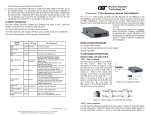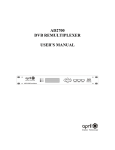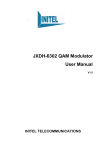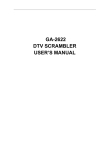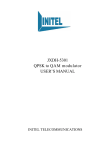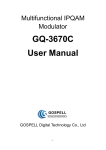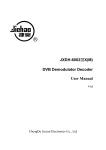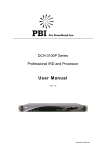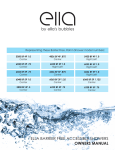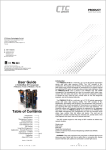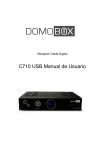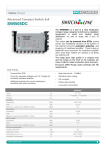Download ad3710 qpsk digital modulator user`s manual
Transcript
AD3710 QPSK DIGITAL MODULATOR USER’S MANUAL CONTENTS 1 SAFETY INSTRUCTIONS……………………………………………………………. 1-1 2 COMPOSITION OF SYSTEM AND OPERATING PRINCIPLE………..… 2-1 2.1 COMPOSITION OF SYSTEM…………………………………………..………..…… 2-1 2.2 OPERATING PRINCIPLE…………………………………………………………..…… 2-1 3 MAIN FEATURES………………...………………………………………….………… 3-1 4 TECHNICAL SPECIFICATION…………..…………………………………..………4-1 4.1 DATA INTERFACE……………………………………………………………….……… 4-1 4.1.1 ASI INTERFACE…………………………………………………………….…… 4-1 4.1.2 SPI INPUT INTERFACE……………………………………….……………… 4-1 4.2 RF INTERFACE……….………………………………………………….……………… 4-1 4.3 CHANNEL SIGNAL ENCODING………………………………………..……………… 4-2 4.4 NETWORK MANAGEMENT INTERFACE……………………………….…………… 4-2 4.5 POWER SUPPLY………………………………………………………………….…….. 4-2 4.6 OPERATION ENVIRONMENT………………………………………………….……... 4-2 4.7 RADIATION AND SAFETY ……………..……………………………………………… 4-2 4.8 MECHANIC CHARACTERISTICS:………………………………………………..…… 4-2 4.9 E3/DS3 INTERFACE (OPTIONAL) …….………………………………………..….… 4-2 5 EQUIPMENT CONNECTIONS……………………………………………………… 5-1 5.1 PANEL DISPLAY AND KEYBOARD…………………………………………………… 5-1 5.2 FRONT PANEL SKETCH……………………………………………..………………… 5-2 5.3 REAR PANEL SKETCH…………………………………………………….…………… 5-2 5.4 SPI INPUT AND OUTPUT INTERFACE CHARACTERISTICS……………..……… 5-2 6 PARAMETER CHECK AND SETUP …………………………………………...… 6-1 6.1 KEYBOARD FUNCTION………………………………………………………………… 6-1 6.2 OPERATION MODE SELECT……………………………………………………..…… 6-1 6.3 HOW TO SET AND CHANGE PARAMETERS…..…………………………………… 6-2 7 SYSTEM ERRORS AND DEBUGGING…………………………….………….… 7-1 7.1 INDICATOR LIGHTS…………………………………………………………..………… 7-1 7.2 TROUBLE SHOOTING………….………………………………………….…………… 7-1 8 NETWORK MANAGEMENT………………………………………………………… 8-1 1 Safety instruction 1.1 Before starting using this unit, please be sure to refer to this manual. 1.2 Do not to open the cabinet, otherwise the guarantee to repair are not available. Meanwhile touching the inside makes you in great danger of electric shock. 1.3 Please make sure to cut off the power supply if you will not use this unit in long term, and do not use any broken jack, which could result in fire or electric shock. 1.4 Wet hands are forbidden to touch the power jack, to avoid risk of electric shock. 1.5 Please pull the plug itself instead of the wire when you pull out power plug,. 1.6 Any thing flammable and metal or liquid, which will destroy the unit, must be kept out the box. 1.7 Do not place this unit in a location near a heat source such as radiator or air ducts, or in a place exposed to direct sunlight, excessive dust, moisture, rain, mechanical vibration. 1.8 Keep the device working in a good ventilative environment, if not the destruction will occur. 1.9 Please keep the packaging for the safety of transit. NOTE: After all parameters are set up, please press the LOCK button. When LCD display is dark, the protection function takes effect. 1-1 2. Composition of system and operating principle 2.1 Composition of system THE SYSTEM CONSISTS UNITS OF THE FOLLOWING CHART QPSK Digital Modulator is mainly composed of the following modules: Data processing unit The unit converts signals from different interfaces into standard signal, then make data processing to carry out the preprocess of QPSK modulating. QPSK modulating unit The unit modulates data stream into frequency spectrum signal. RF output250MHz~2700MHz CPU/LCD/LED/Keyboard unit The unit carries out keyboard input, LED display and intelligent control, etc. 2.2 Operating principle AD3710 QPSK Digital modulator converts input data streams into frequency signals, it meets to DVB-S standard. Signals from MPEG-II compact encoder or multiplexer was sent into QPSK modulator. According to DVB standard, such as interlacing, RS error correction encoding, etc. After up-converting into the range of TV channels, signals can be transmitted through HFC and MMDS networks. It’s widely used in digital TV, data broadcasting, VOD, Internet, video conference etc. 2-1 3. Main features DVB-S Standard for error correction encoding, Input bit rate::1~60M bps Output symbol rate: :1~45Mbaud(adjustable),1Kbaud step Output band width::1.25~56.25MHz(Roll-fall modulus0.25) Output level:100dBuV~110dBuV(step adjustable) 188 and 204 packet automatic identification Output frequency 250MHz~2700MHz(adjustable in segment),min step:50KHz NIT mapping and sending, support 44 NIT mapping PID filtering and re-mapping PSI/SI information pick-up, parse and modification SI information replacement and insert Input data null packet filtering and output data filling. PCR correction Show and inspect system input bit rate and valid bit rate real time 3-1 4. Technical specification 4.1 Data interface 4.1.1 ASI interface (Asynchronous Serial interface) A:Input: Connector: BNC Impedance: 75Ω Packet format: 188/204 bits Access data rate: 270Mbps Max valid bit rate: 60Mbps DVB standard B: Loop output: Connector: BNC Impedance: 75Ω 4.1.2 SPI input interface (Synchronous Parallel interface) Connector: DB-25 female Packet format: 188 or 204 bits DVB Standard: LVDS 4.2 RF interface A. RF output: Connector: BNC Impedance: 75Ω Output Frequency: 250MHz~500MHz, 450MHz~950MHz,950MHz~1800MHz(Supplied by different unit) Reflect loss ≥15dB Output level: 100~110dBuV (adjustable) Carrier rejection: > 55dB SNR(out of band):≥45dB B: RF output for test Connector: BNC Impedance: 75Ω Output level: 85dBuV~100dBuV (adjustable) 4-1 4.3 Channel signal encoding Constellation: QPSK Channel encoding: RS encode, DVB-C/DVB-S standard MER:≥40dB SNR(out of band):≥45dB 4.4 Network management interface IEEE802.3 ETHERNET, RJ45 interface Software protocol: SNMP protocol 4.5 Power supply Voltage: 165~265VAC or 85V~265V AC Frequency: 50Hz±2% Power consumption: 50W 4.6 Operation environment Operation temperature: +5~45°C; Storage temperature: -25~+55°C. Relative humidity: 10~75% 4.7Radiation and safety Up to GB13837-92 and GB8898-88 4.8 Mechanic characteristics Dimension: 44.5mm(1U)*483mm*(19”)*400mm Weight: 6kg 4.9 E3 /DS3 Interface (optional) A: Input (G.703 standard) Connector: BNC Impedance: 75Ω Packet format 188/204 bits Bit rate: E3/DS3 No-frame format (34.368Mbps/44.736Mbps) B: Output (loop) Connector: BNC Impedance: 75Ω Note: The information contained herein is subject to change without notice. 4-2 5. Equipment connection 5.1 Panel display and keyboard A. Panel display a. LED instruction Power Sync Alarm b: LCD B: Keyboard ARROW KEYS (UP/DOWN/LEFT/RIGHT) ENTER LOCK: press once to lock; press once again to unlock MENU 5.2 Front Panel Sketch 5-1 Front panel 5-1 5.3 Rear panel sketch 5-2 Rear panel 5.4 SPI input and output interface characteristics No Signals Description No Signals 1 2 3 4 5 6 7 8 9 10 11 CLK-A GND D7-A D6-A D5-A D4-A D3-A D2=A D1-A D0-A DVALID-A 12 PSYNC-A 13 CABLE Signal clock GROUND DATA 7 DATA 6 DATA 5 DATA 4 DATA 3 DATA 2 DATA 1 DATA 0 DATA AVAILABLE PACK SYNCHRONOUS SHEILD CABLE 14 15 16 17 18 19 20 21 22 23 24 CLK-B GND D7-B D6-B D5-B D4-B D3-B D2-B D1-B D0-B DVALID-B 25 PSYNC-B 5-2 Description Signal clock GROUND DATA 7 DATA 6 DATA 5 DATA 4 DATA 3 DATA 2 DATA 1 DATA 0 DATA AVAILABLE PACK SYNCHRONOUS 6.Parameter check and setup 6.1 Keyboard Function Move Right/Left key: choose sub-menu/move cursor Move up/down key: setup cursor/change parameters Enter: confirm operations Lock: lock/unlock the keyboard /remote-control/exit menu MENU: Select main menu and cancel operations Note: 1.Be sure to press ENTER key after setup the parameters, all new parameters will take effect only without *, otherwise the old parameters will be kept. 2. Under any status of setting parameters, press LOCK key will make unit return to the status of showing operating parameters. 6.2 Operation mode select (keyboard unlocked) Press MENU to display main menu circularly ONCE 1.0 VIEW ALARMS ALARMS LIST EMPTY TWICE 2.0 QPSK OUTPUT SYMBOL 27.500MBd[38.014Mbps] THRICE 3.0 RF OUT FREQUENCY 200.0000MHz FOUR TIMES 4.0 SIGNAL IN PORT ASI FIVE TIMES 5.0 BYPASS SWITCH OFF SIX TIMES 6.0 NIT TABLE MODE KEEP ORIGINAL NIT SEVEN TIMES 7.00.0 INPUT TS ALL HAVE: 011 EIGHT TIMES 8.00.0 OUTPUT TS OUT PROGRAMS:011 NINE TIMES 9.0 QPSK OUTPUT MODE WORK AS INPUT TS 6-1 6.3 How to set and change parameters 6.3.1 Set system parameters A、 Press MENU once: display as follows 1.0 VIEW ALARMS ALARMS LIST EMPTY or NO INPUT SIGNAL or RF UNLOCK or BUFFER FULL or SYSTEM ERROR B、 Press UP/DOWN key to view/change parameters /select functions 61.0 VIEW ALARMS CLRAR ALL ALARMS C、Press(Enter):to store change or confirm operation 1.0 VIEW ALARMS ALL ALARMS BE CLEARED D、Press LEFT/RIGHT to view sub-menu 41 1.1 SET IP ADDRESS 120.120.120.160 42 1.2 SET NET MASK 255.255.255.000 43 1.3 SET NET GATE 120.120.120.001 44 1.4 NET STATUS NOT CONNETTED - CONNETTED 45 1.5 SERIAL No.: XXXXXXXXXXXXXXXXXX (18-digits) 46 1.6 VERSION H:XX.XX S:XX.XX 47 1.7 GET PRESET PARAMETER *FACTORY PRESET Press ENTER to store exchange. 48 1.8 RELOAD IN INFO(Reload input parameters) *RELOAD IN CHANNEL(Reload input channel parameters) E、In any status, press LOCK to exit 6.3.2 Set QPSK parameters A、Press MENU twice: display as follows 2.0 QPSK OUTPUT SYMBOL 27.500MBd[38.014Mbps] or 27.500MBd[34.375MHz] 6-2 B、Press UP/DOWN to view/change parameters or select function C、Press ENTER to store exchange or confirm operation D、Press LEFT/RIGHT to view sub-menu 41 42 2.1 FEC MODE 3/46*5/66*7/86*1/26*2/3 2.2 BW PREFERENCES UNIT uc Bitrate (valid data rate) 6.3.3 Set RF parameters A、Press MENU three times, display as follows 3.0 RF OUT FREQUENCY: 200.0000MHz Please refer to SET SYMBOL RATE to set new frequency. B、Press LEFT/RIGHT to view sub-menu 41 3.1 RF OUTPUT LEVEL: 115dBuV or 110dBuV C、Press UP/DOWN to plus or minus 0.5dBuV(don’t need to press ENTER) 42 43 3.2 QPSK MODULATION ON6*OFF 3.3 RF POWER SWITCH(RF output control) ON6*OFF D、Press(Enter):to store exchange or confirm operation E、In any status, press LOCK will exit. 6.3.4 Select input interface A、Press MENU four times:display as follows 4.0 SIGNAL INPUT IN PORT(select input interface) INPUT FROM ASI6* INPUT FROM SPI6* INPUT FROM E36* INPUT FROM DS3 41 4.1 SIGNAL TYPE 188 BYTES PACKET-204 BYTES PACKET-IN PORT NO SIGNAL 42 43 4.2 IN TS ALL RATE(The total rate of input signal) 038.051Mbps 4.3 TS EFFECT RATE(The valid rate of input signal) 033.160Mbps 6-3 6.3.5 PID mapping and Filter A、Press MODE 5 times:display as follows 5.0 BYPASS SWITCH ON 6*OFF 41 5.1 BYPASS PID0 CH1 0032 → 0032(D)(PID bypass) 62 5.2 BYPASS PID1 CH1 0032 → 0120(D)(PID mapping) 63 5.3 BYPASS PID2 CH1 0032 → 8191(D)(PID filter) 64 5.4 BYPASS PID3 CH1 8191 → 8191(D)(Null packet filter) 65 5.5 BYPASS PID4 CH1 8191 → 8191(D)(Null packet filter) 66 5.6 BYPASS PID5 CH1 8191 → 8191(D)(Null packet filter) 67 5.7 BYPASS PID6 CH1 8191 → 8191(D)(Null packet filter) 68 5.8 BYPASS PID7 CH1 8191 → 8191(D)(Null packet filter) B、Press UP/DOWN key to view/change parameters or select functions C、Press ENTER to store exchange or confirm operation D、Press LEFT/RIGHT to view sub-menu. E、In any status, Press LOCK to exit. 6.3.6 Insert NIT A、Press MENU six times, display as follows 6.0 NIT TABLE MODE KEEP ORIGINAL NIT 6*EXCHANGE OLD NIT 41 6.1 NETWORK ID 00001(read only) 62 6.2 NETWORK NAME TEST( ready only) 63 6.3 CHANNELS IN NIT 001( ready only) B、Above is controlled by NMS. 6-4 6.3.7 Check input TS parameters A、Press MENU seven times or ENTER three times,display as follows 7.00.0 INTPUT TS(Check input parameters) ALL HAVE:011(The quantity for input program) B、Press LEFT/RIGHT to check TS identity No. 41 7.00.1 INPUT SIGNAL(The packet format of input signal ) INPUT 188 TS PACKET(read only) 42 7.00.2 IN TS TS_ID(The ID for input TS) 00010(read only) 43 7.00.3 IN TS ON_ID(ID for original input TS) 00001(read only) 44 7.00. 4 IN ALL RATE(Total rate of input signal) 038.051Mbps(read only) 45 7.00.5 IN TS EFFECT (Valid rate of input signal) 033.160Mbps(read only) C、Press UP/DOWN to view signal source 51 7.01.0 PROG01 NAME CCTV 4(read only) 52 7.02.0 PROG02 NAME CCTV 9(read only) 53 7.03.0 PROG03 NAME CCTV OPERA(read only) | | | 516 7.16.0 PROG16 NAME SHENZHEN(read only) D、Press UP/DOWN to view/change parameters of all programs, press ENTER to tore the change,press MENU to exit current operation. 47.01.0 PROG01 NAME 6-5 CCTV 4(read only) 41 7.01.1 PROG01(CHA01) (Select output program 1 ) REMULTIPLEXED/*NOT BE MULTIPLEXED(setable) 42 7.01.2 P01 CODE RATE(CHA01) (Valid rate for input program 1) 004.075Mbps(read only) 43 7.01.3 P01 PMT PID(PMT PID for program 1) 0100(HEX) 0256(DEC) (read only) 44 7.01.4 P01 PCR PID(PCR PID for program 1) 0902(HEX) 2306(DEC) (read only) 45 7.01.5 P01 MPEG-2 V (Video PID for program 1) 0200(HEX) 0512(DEC) (read only) 46 7.01.6 P01 MPEG-1 A(Audio PID for program 1) 028A(HEX) 0650(DEC) (read only) The operation is the same as above for the parameters setup of other programs 6.3.8 Output TS setup A、Press MENU eight times or ENTER twice, display as follows: 8.00.0 OUTPUT TS OUT PROGRAMS:011 B、Press UP/DOWN to view/change TS ID. 41 8.00.1 OUTPUT TS_ID 00010 (changeable) 42 8.00.2 OUTPUT ON_ID (Original Output TS ID) 00001(changeable) 43 8.00.3 CAT WORK MODE (CAT control mode) MAKE A NEW TABLE (Insert new CAT) 5*NOT MAKE NEW TABLE (Not insert new CAT) 44 8.00.4 SDT WORK MODE (SDT control mode) MAKE A NEW TABLE (Insert new SDT) 5*NOT MAKE NEW TABLE (Not insert new SDI) C、Press UP/DOWN to view all program source 6-6 51 8.01.0 P01 FROM PROGRAM 01 IN CHA01 (Program 1 is from channel 1) 52 8.02.0 P02 FROM PROGRAM 02 IN CHA01 (Program 2 is from channel 1) 53 8.03.0 P03 FROM PROGRAM 01 IN CHA01 | | | 516 1 8.16.0 P16 FROM PROGRAM 11 IN CHA01 D、Press UP/DOWN to view/change parameters of all programs, press ENTER to tore the change,press MENU to exit current operation. 41 8.01.1 P01 NAME CCTV 4 (changeable) 42 8.01.2 P01 NUMBER (Program ID NO. of output program 1) 00001(changeable) 43 8.01.3 P01 PMT PID(PMT PID of output program 1) 0100(HEX) 0256(DEC) (Re-mapping available,setup to be 8191 to filter PID) 44 8.01.4 P01 PCR PID(PCR PID for program 1) 0902(HEX) 2306(DEC) (Re-mapping available,setup to be 8191 to filter PID) 45 8.01.5 P01 MPEG-2 V(Video PID for program 1) 0200(HEX) 0512(DEC) (Re-mapping available,setup to be 8191 to filter PID) 46 8.01.6 P01 MPEG-1 A(Audio PID for program 1) 028A(HEX) 0650(DEC) (Re-mapping available,setup to be 8191 to filter PID) The operation is the same as above for the parameters setup of other output programs 6-7 6.3.9 NIT setup A、Press MENU nine times or ENTER once9,display as follows: 9.0 QPSK OUTPUT MODE WORK AS INPUT TS 6* WORK AS OUTPUT TS B、Press LEFT/RIGHT to view/change NIT info, press ENTER to confirm the exchange and press MENU to exit current operation. 41 9.1 QPSK OUTPUT PARA WORKING AS SETTING 6* REBUILDING PARA Or NEED REBUILD PARA 6-8 7、System errors and debugging 7.1 Indicator lights There are three LED indicator lights. 1)“POWER” lights up (Red) means power switch on and working orderly. 2) “ STATUS” lights up(Green) means synchronization clock working orderly. 3) “ALARM” lights up(Green) means data processing working orderly. 7.2 Trouble Shooting 7.2.1 The ”POWER” indicator light does not illuminate. Please check the wire to make sure the wire is connected to the socket properly and the power switch is on. 7.2.2”STATUS” illuminates (in red ) This means lack of synchronal signals or input data abnormal or no valid data input, please check the input data cable is connected properly, and the input interface is selected correctly. If the answer is yes, it means the unit is broken, needs to be replaced. 7.2.3”AlARM”flashes This means the equipment is out of order for some faults. Please debug according to the instruction from LCD. 7-1 8、Network management The unit could be controlled remotely via network management software. Please refer to 《NMS user’s manual》 8-1



















